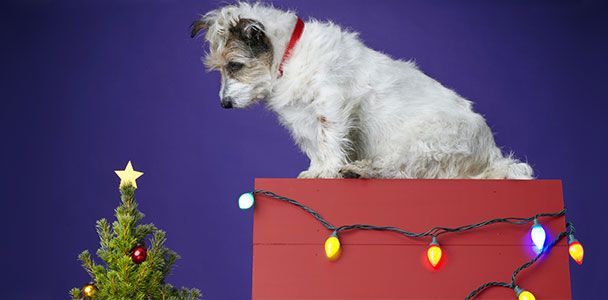The holiday season brings joy, festivity, and a flurry of activity to our homes. However, dogs can face unexpected hazards during this time of year. As responsible pet owners, it’s important to make sure our homes are safe and welcoming for our pets—and guests—during the holidays. Learn how to keep your dog from fatty treats, foot traffic, and festive decor.
Holiday Hazards for Dogs
The holidays introduce many new elements into our homes that can pose risks to our dogs. From decorations to particular foods, you should be aware of potential dangers and take steps to mitigate them.
Common Household Dangers
Many everyday items are used more during the holiday season and can be hazardous to dogs. These include the following:
- Electrical cords from holiday lights
- Small ornaments that can be swallowed
- Tinsel and garland that can cause intestinal blockages
- Candles that may burn curious noses
- Gift wrapping materials like ribbon and tape
To keep your dog safe, store these items out of reach when not in use and supervise your pet closely when decorations are on display.
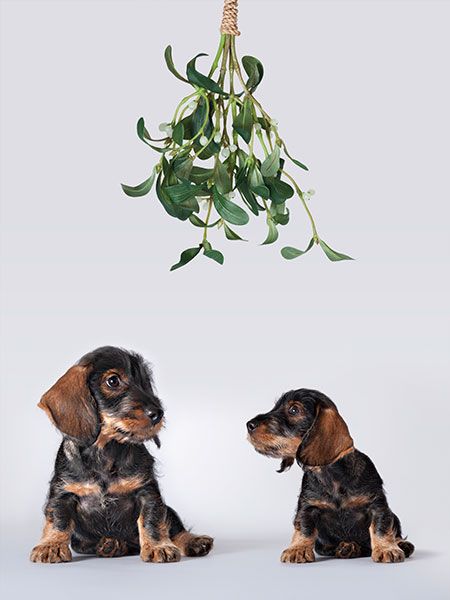
Seasonal Risks to Watch For
The holidays bring specific seasonal risks that dog owners should also be mindful of:
- Toxic plants like poinsettias, mistletoe, and holly
- Rich, fatty foods that can cause digestive issues
- Increased foot traffic and open doors that may lead to escapes
- Stressful changes in routine and environment
Awareness of these risks is the first step in creating a safe holiday environment for your dog. Additionally, it’s important to recognize that dogs may become more curious with all the new sights and smells around them. This curiosity can lead them into trouble if appropriate precautions are not taken.
Securing Your Christmas Tree and Decorations for Dog-proofing
The Christmas tree is often the centerpiece of holiday decor, but it can also be a source of fascination—and potential danger—for dogs. The allure of shiny ornaments and twinkling lights can be too tempting for a pup to resist.
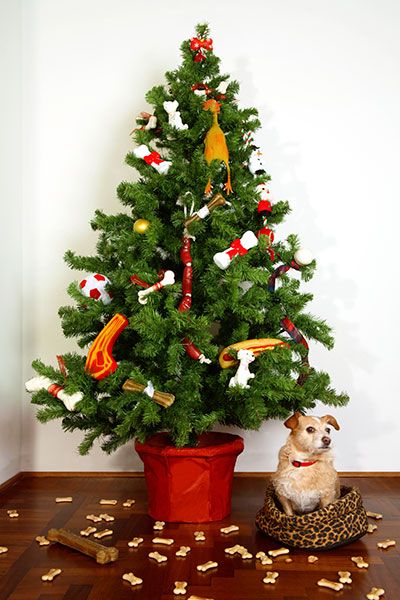
Choosing a Pet-Safe Christmas Tree
When selecting a Christmas tree, consider these pet-friendly options:
- Artificial trees that don’t shed needles
- Smaller tabletop trees placed out of reach
- Trees secured to the wall or ceiling to prevent tipping
If you opt for a real tree, make sure your dog doesn’t have access to the water stand, which can contain harmful bacteria and tree preservatives. Some pet owners may consider using a tree fence or playpen to create a physical barrier between their dog and the tree. This can keep dogs from getting too close and causing mischief.
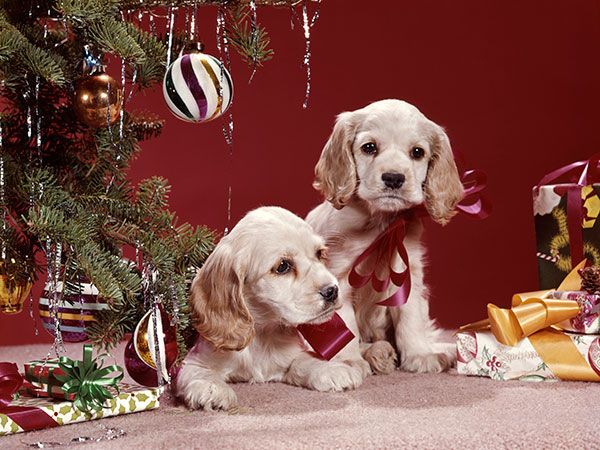
Safely Hanging Ornaments and Lights
To decorate your tree safely:
- Hang breakable ornaments higher up on the tree
- Avoid using tinsel, which can be dangerous if ingested by your dog
- Secure lights firmly to prevent chewing
- Use pet-safe, non-toxic ornaments on lower branches
Remember to keep a close eye on your dog when they’re near the tree, and consider using only shatterproof ornaments to reduce the risk of injury if an ornament falls.
Managing Holiday Foods and Treats for Your Dogs
Holiday feasts are a highlight of the season, but many festive foods can harm dogs. The abundance of rich and flavorful foods can be tempting, but not all of them are safe for canine consumption.
Toxic Food for Dogs
Some common holiday foods that are toxic to dogs include:
- Chocolate
- Grapes and raisins
- Onions and garlic
- Macadamia nuts
- Xylitol (an artificial sweetener)
Keep these foods out of reach and inform guests not to feed your dog table scraps. Even small amounts of these foods can cause severe health issues in dogs, so it’s important to be vigilant.
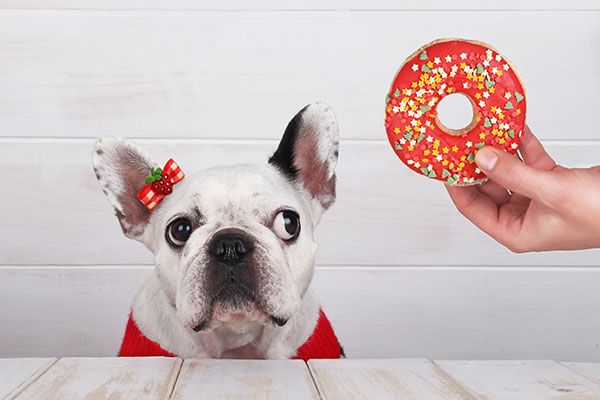
Creating Pet-Friendly Holiday Snacks
To include your dog in the holiday feasting, prepare some dog-safe treats so they can join in the fun, such as:
- Plain, cooked turkey (no skin or bones)
- Raw or steamed vegetables like carrots or green beans
- Small amounts of plain pumpkin puree
- Homemade dog biscuits with pet-safe ingredients
Always introduce new foods gradually and in moderation to avoid upsetting your dog’s stomach. Consider using festive molds to create holiday-shaped treats that are safe and enjoyable for your dog.
Preparing for Holiday Guests and Parties
The influx of visitors during the holidays can be overwhelming for dogs. Preparing your home and your pet for social gatherings is key to a positive experience. Dogs can become stressed with new people, noises, and changes in their environment.
Setting Up a Quiet Space for Your Dog
Create a safe haven for your dog away from the hustle and bustle:
- Designate a room or area as a “dog zone”
- Provide comfortable bedding, water, and their favorite toys
- Use baby gates to restrict access to busy areas
- Consider playing calming music or using pheromone diffusers
This quiet space gives your dog a retreat when they feel overwhelmed by holiday activities. Additionally, laying down a piece of your clothing with your scent in the “dog zone” can give your pet comfort and security.
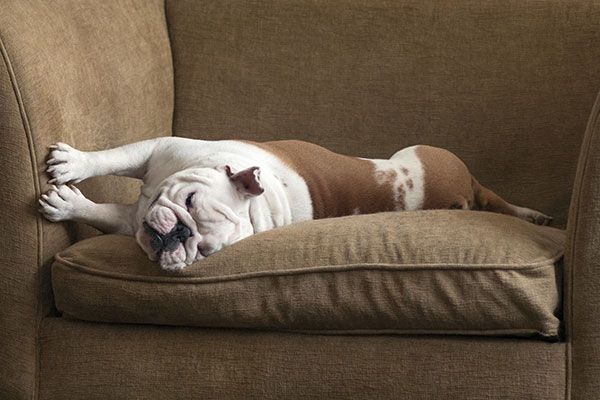
Training Your Dog for Social Situations
To prepare your dog for increased social interactions:
- Practice basic obedience commands
- Gradually expose your dog to new people and sounds
- Reward calm behavior around guests
- Teach your dog to go to their “place” on command
These skills will help your dog navigate holiday gatherings with confidence. Begin training well in advance of the holiday season to make sure your dog is comfortable and well-prepared.
Safeguarding Your Home’s Interior for Dogs
Holiday decorations can make your home merry, but they may also present new challenges for dog-proofing. Upholding the safety of your decorations and furniture is essential for a peaceful holiday season.
Protecting Furniture and Decorations
To keep your festive decor intact:
- Use bitter apple spray on furniture and decorations to deter chewing
- Place fragile items out of reach or in closed cabinets
- Cover upholstered furniture with throws for easy cleaning
- Use sturdy, tip-resistant displays for centerpieces and decorations
These precautions help keep your holiday vibe while helping your dog stay safe. It’s also beneficial to regularly vacuum or sweep to pick up small, potentially hazardous items that may get dropped or broken during decorating.
Managing Cords and Small Objects
Electrical cords are used more than ever during the holidays. Prevent accidents by:
- Hiding or covering electrical cords
- Keeping small decorations and ornament hooks in sealed containers
- Regularly checking floors for dropped items like pins or batteries
- Using cord organizers to bundle and secure wires
Vigilance in managing these potential hazards can prevent emergencies during the holiday season. Consider using cord protectors or tubing to further safeguard electrical cords from curious chewers.

Creating a Pet-Safe Outdoor Environment
The exterior of your home needs attention too, especially if you decorate outdoors or have a yard where your dog spends time.
Securing Your Yard for the Holidays
To be sure your outdoor space remains safe:
- Check fences for gaps or weak spots
- Clear paths of ice and snow to prevent slips
- Store deicing salts and antifreeze out of reach
- Remove holiday plants that may be toxic if ingested
A protected yard allows your dog to enjoy outdoor time safely during the holidays and might even give them another area to escape for some peace.
Managing Holiday Lights and Decorations Outside
When decorating your home’s exterior:
- Use pet-safe LED lights that stay cool to the touch
- Secure inflatables and lawn ornaments to prevent tipping
- Avoid low-hanging decorations that dogs might chew
- Keep cords and stakes covered or out of reach
These precautions allow you to decorate with festive outdoor items without compromising your dog’s safety. On top of that, make sure any electrical connections are weatherproof and that cords are properly insulated to prevent electrical hazards.
Maintaining Your Dog’s Routine During the Holidays
Amidst the holiday chaos, keeping your dog’s regular schedule is beneficial for their well-being and behavior. Consistency provides a sense of security and helps minimize stress for your dog.
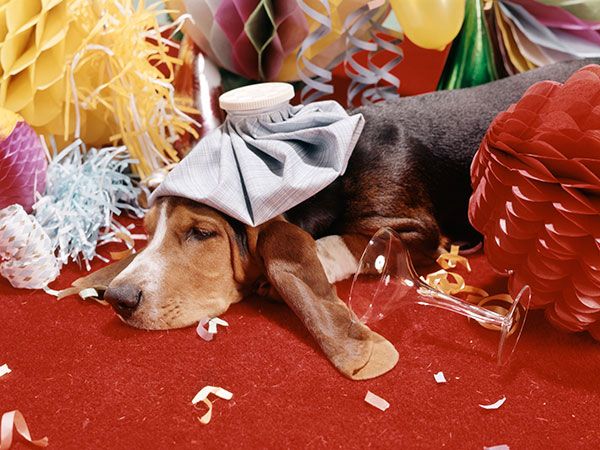
Regular Feeding and Exercise Schedules
With feeding and exercise for your pets, consistency is key:
- Feed your dog at their usual times
- Keep your regular walk and playtime schedules
- Give them exercise before guests arrive to help calm your dog
- Consider hiring a dog walker if your schedule becomes hectic
Mental Stimulation During Busy Times
To keep your fur baby engaged and content:
- Use puzzle toys and treat-dispensing games
- Practice new tricks or reinforce training
- Rotate toys to keep their interest
- Spend quality one-on-one time with your dog daily
Mental stimulation can prevent boredom-related behaviors and help your dog burn off energy before any holiday guests arrive.
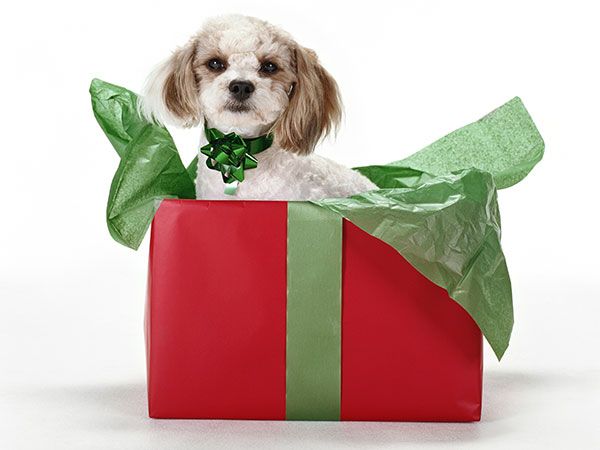
Handling Holiday-Specific Challenges
Certain holiday events call for dog owners to be particularly prepared. Understanding these challenges can help calm your dog and make them feel safe.
New Year’s Eve Fireworks and Noise
To prepare for loud celebrations:
- Create a sound-insulated area for your dog
- Use white noise machines or calming music
- Consider anxiety wraps or calming supplements (consult with your vet)
- Stay home with your dog if they’re noise-sensitive
These strategies can help your dog cope with the excitement of New Year’s Eve. It’s important to monitor your dog’s behavior and provide comfort if they show signs of distress during fireworks or other loud events, which is perfectly normal for many dogs.
Traveling with Your Dog During the Holidays
If you’re hitting the road:
- Be sure your dog is comfortable with car travel
- Pack familiar items like beds and toys
- Plan for regular breaks and exercise
- Research pet-friendly accommodations in advance
Good planning makes holiday travel with your dog smoother and more enjoyable for everyone. To be extra safe, make sure your dog is properly identified with tags and a microchip in case of accidental separation during travel.
